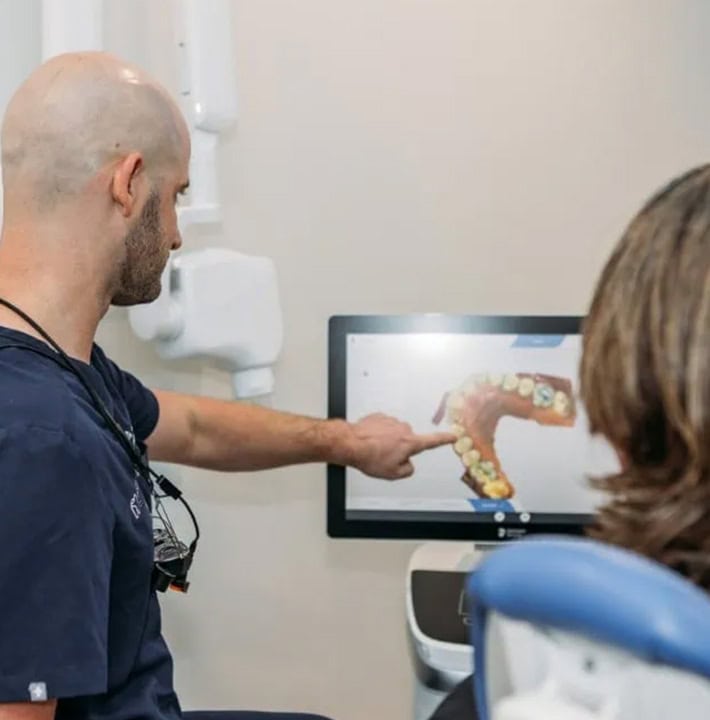Your Destination For High-Quality And Effective Orthodontics
Achieve the smile you want with orthodontics. We provide effective, personalised treatment plans featuring discreet options that maintain comfort while straightening teeth.
Braces or Clear Aligners? Listen to Tim on which is best for you.

Orthodontics And Its Impact On Achieving Balanced, Aligned, And Healthy Smiles
A beautiful, balanced smile is often compromised by misalignment, which can result from many factors like genetics, injuries, or bad oral habits. These common issues can affect overall dental health and lead to discomfort when chewing or speaking, impacting one’s self-confidence during social interactions.
Orthodontic services effectively address these common concerns by aligning crooked teeth and bites, which enhances both functionality and aesthetics. Improved alignment not only alleviates discomfort but also promotes better oral hygiene, leading to a healthier, more attractive smile.

How To Determine If You Are A Candidate For Orthodontics
Assessing if you’re an ideal candidate for orthodontics is an important part of an effective treatment. Consider the following characteristics to see if orthodontic treatment might be right for you:
- Patients with misaligned teeth, gaps, or bite issues, such as overbites or underbites, are strong candidates for orthodontic treatment.
- Adequate bone density in the jaw is necessary to support tooth movement during the treatment.
- Active dental conditions, like cavities or gum infections, must be addressed before starting orthodontic treatment to avoid complications.
- Good oral hygiene is essential, as orthodontic appliances can increase the risk of plaque and food accumulation around the teeth.
What Are The Key Benefits Of Choosing Orthodontic Treatments?
Orthodontic treatments offer more than just aesthetic improvements; they contribute significantly to the patient’s oral health and overall quality of life. Here are the most valuable benefits of orthodontic treatment:
- Enhancing the alignment of teeth boosts confidence and self-esteem by creating a more appealing smile.
- Straightening crowded teeth improves oral hygiene by making it easier to clean between teeth, reducing the risk of decay and gum disease.
- Proper alignment can alleviate stress on the jaw and teeth, preventing long-term damage and reducing discomfort from an improper bite.
- Properly aligned teeth contribute to better overall health by improving oral functionality and digestion.

Orthodontic Services
Achieving a straighter smile is possible through orthodontics in Inglewood, which offers comfort and convenience while addressing alignment issues.
Schedule Your Consultation Today
Experience Exceptional Dental Treatments for a Healthier, Brighter Smile

Frequently Asked Questions
Do orthodontic treatments hurt, and how can discomfort be managed?
Yes, orthodontic treatments can cause some discomfort, but it is mild and manageable. This is due to the pressure applied to your teeth as the custom-made braces or aligners work to gradually shift your teeth into their ideal positions. This pressure is necessary for the teeth straightening devices to effectively align the teeth and jaw over time. However, it can lead to temporary soreness or discomfort as your mouth adjusts to the changes.
Here’s how to effectively manage this discomfort:
- Apply ice packs:
Ice packs can be placed on the affected area to reduce swelling and numb soreness. The cold helps constrict blood vessels, which can lessen the pain and decrease inflammation. - Use dental wax:
You can apply dental wax to any brackets or wires that are causing discomfort. This forms a protective barrier, reducing friction and preventing sores in your mouth. - Eat soft foods:
Opting for soft foods like yoghurt, smoothies, and soups avoids straining your teeth, as these foods do not require much chewing. Doing this can significantly ease the pressure on your teeth and gums during sensitive periods. - Rinse with saltwater:
Rinsing with warm salt water several times a day can help soothe sore gums and speed up the healing of any mouth sores. The salt acts as a natural disinfectant, reducing the risk of infection. - Over-the-counter pain relievers:
Non-prescription pain relief medications can be used, as advised by a healthcare professional, to manage pain effectively. They can reduce swelling and block pain signals.
While the initial adjustment to orthodontic treatment options can bring discomfort, these strategies can help alleviate it. Remember, these discomforts are a normal part of the path towards achieving a well-aligned, beautiful smile and improved oral health.
How long does orthodontic treatment typically take?
The duration of orthodontic treatment varies depending on the specific method used and the patient’s dental needs. Here are the common orthodontic treatment options and their durations:
- Clear Aligners:
Invisalign, for example, is worn for 12 to 18 months on average. They are removable and need fewer adjustments. Treatment time can be shortened if aligners are used consistently and properly. - Traditional Metal Braces:
These are the most commonly chosen type, which are usually worn for about 18 to 24 months. The duration reflects the time needed for metal brackets and wires to effectively move teeth into the desired position. - Ceramic Braces:
Similar to metal braces, ceramic braces often need 18 to 24 months of treatment. They function like metal braces but are less noticeable since they use clear or tooth-coloured brackets. - Lingual Braces:
These braces are fitted behind the teeth and can take 18 to 36 months to complete treatment. This extended duration may be due to the braces being less accessible and more challenging to adjust.
Understanding these options helps you choose a treatment that suits your lifestyle and dental goals. Each method is designed to move teeth effectively, though the time involved can vary based on the complexity of the dental issues and adherence to the treatment plan.
Can orthodontics help with jaw alignment issues?
Yes, orthodontics can help with jaw alignment issues. Appliances such as braces, clear aligners, and palatal expanders effectively manage overbites, underbites, and crossbites.
Braces are particularly versatile, applying continuous pressure to move teeth and jaws into better positions. Clear aligners might be unsuitable for severe jaw misalignments because they offer less force than braces. Palatal expanders are effective for expanding the upper jaw but aren’t designed for adjustments to the lower jaw. Consulting with a dentist is necessary to determine the most effective treatment for specific alignment concerns.
How often will I need to visit the dentist during my orthodontic treatment?
During orthodontic care, visits to the dentist are required every four to eight weeks. These regular check-ups are necessary for a number of reasons:
- Adjustment of appliances:
To keep your braces working effectively in straightening your teeth, your dentist makes regular adjustments to them. For patients wearing clear aligners, new sets of aligners are given to change every two weeks. - Monitoring progress:
Regular check-ups allow the dentist to track how your teeth are moving and make any necessary adjustments to the treatment plan. - Addressing discomfort or issues:
If you experience any pain or other issues, the dentist can address these promptly to prevent further complications. - Maintaining oral health:
These visits help prevent dental health issues such as gum disease and tooth decay, which are key to the success of your treatment.
Regular check-ups are important for the smooth progress of your orthodontic treatment. These visits allow your dentist to check your progress and make necessary adjustments to your treatment so you achieve your desired outcomes effectively.
What age is ideal for children to begin orthodontic treatment?
The ideal age for children to begin orthodontic treatment varies depending on the issue being addressed. However, children can undergo orthodontic evaluation as early as seven years old. At this age, a dentist can assess how the adult teeth are starting to develop and identify any early issues with jaw growth. Early detection allows for timely interventions, which can guide the proper growth of the jaw and alignment of the teeth, often reducing the need for more invasive treatments later. This proactive approach addresses orthodontic issues early, preventing them from becoming more complicated and leading to better dental health outcomes for the child.
Can adults still get orthodontics for teeth straightening?
Yes, adults can still get orthodontics for teeth straightening. Any orthodontic treatment options are effective at any age if the teeth and gums are healthy.
While adults can benefit from orthodontics just like younger individuals, their treatment might differ because their bones are no longer growing, which may slow down the teeth-moving process. Moreover, adults often have dental conditions such as gum disease or missing teeth that need to be addressed prior to starting their orthodontic treatments.
Clear aligners or ceramic braces offer discreet treatment options that fit better into adult lifestyles. Although it might take longer for adults, the benefits of orthodontic treatment on their oral health make it worthwhile.
How much do orthodontic treatments usually cost?
Orthodontic treatment costs vary based on the treatment type and the complexity of each case. Here’s an overview of the average costs of these dental services:
- Invisalign (full treatment):
The cost of this treatment can range from $6,000 to $9,000. Invisalign aligners are removable and convenient, customised to fit each patient’s specific dental needs. - Traditional metal braces:
These can cost up to $8,000. They are a common option, providing effective teeth straightening with metal brackets and wires. - Ceramic braces:
These range from $5,000 to $8,500. Ceramic braces function like metal braces but use tooth-coloured brackets, making them less noticeable. - Lingual braces (single arch):
Cost starts at $7,500; lingual braces are placed behind the teeth, offering a discreet alternative for those wanting a less noticeable treatment option. - Lingual braces (full treatment):
Full treatment costs start from $12,500, reflecting the complexity of placing braces on both the upper and lower arches. - Clear braces:
These range between $2,000 and $9,000. Clear aligners are nearly invisible, custom-made, and suitable for those wanting a more subtle option.
The exact cost depends on factors such as treatment duration, appliance type, and any additional dental procedures required. Discussing options with a dental professional will provide the most accurate cost estimate.
What happens during an initial orthodontic consultation?
During an initial orthodontic consultation, a dental professional assesses your oral health and discusses possible treatment options. Here’s what to expect during this comprehensive consultation at the dental clinic:
- Examination of the teeth and mouth:
The dentist will examine your teeth, gums, and bite to identify alignment issues and any underlying oral health problems. - Dental X-rays:
X-rays provide a detailed view of the teeth, roots, and jawbone, allowing the dentist to evaluate the position and growth of teeth. - Impressions or digital scans:
The dentist may take impressions or use digital scans to create a model of your teeth for treatment planning. - Discussion of the treatment options:
Based on the results of the examination, your dentist will discuss with you the suitable orthodontic treatments available. This might be braces or aligners. - Cost and timeline overview:
The dentist will also provide information about the cost, duration, and steps involved in the proposed treatment plan. - Questions and concerns:
You’ll have an opportunity to ask questions and discuss any dental concerns about the process to help you feel informed and confident with your treatment.
The initial consultation allows for a comprehensive smile assessment and for patients to have a clear understanding of what to expect and the steps involved in orthodontic treatment. This detailed approach allows our friendly staff to help you decide how to proceed with orthodontics.
How should I care for my teeth during orthodontic treatment?
Maintaining proper care for your teeth during orthodontic treatment is key to maintaining oral health and achieving the desired results. Here are the steps you should follow to keep your healthy teeth in good condition and maximise the benefits of orthodontic treatment:
- Brush after every meal:
To thoroughly clean your teeth, use a soft-bristled toothbrush and fluoride toothpaste to remove plaque and food particles. - Floss daily:
Use orthodontic floss threaders or special floss designed for braces to clean between teeth, preventing plaque buildup in difficult-to-reach areas. - Use an interdental brush:
Use an interdental brush to clean around brackets and wires. Doing so will help keep your braces free from trapped food particles. - Mouthwash rinse:
Use an antibacterial mouthwash to rinse your mouth daily, helping to reduce bacteria and freshen your breath during treatment. - Limit hard and sticky foods:
Stay away from foods like nuts, popcorn, caramel, and chewing gum that can damage brackets or wires. - Regular check-ups:
See your dentist every four to eight weeks to monitor your progress, clean your teeth, and address any potential issues.
Maintaining a consistent oral health routine during treatment protects your natural teeth from decay and staining. Staying diligent with these practices will make your teeth straightening journey easier and maintain your flawless, healthy-looking smile.
Are there any foods I should avoid while undergoing orthodontic treatment?
Yes, there are specific foods you should avoid while undergoing orthodontic care, but this depends on the type of treatment you choose.
When opting for Invisalign or other clear aligners, patients benefit from fewer dietary restrictions. Aligners must be removed before eating, allowing patients to maintain their regular diet without limitations. However, for beverages, only lukewarm or cold water is safe to drink while wearing the aligners. Consuming other drinks requires removing the aligners to prevent potential warping, discolouration, and damage.
On the other hand, here’s a list of food options to avoid if you have orthodontic braces:
- Hard foods:
These are food items like hard candies, nuts and ice that can break brackets or wires, causing delays in treatment and discomfort. - Sticky foods:
Caramel, toffee, and chewing gum are sticky foods that will likely get stuck in dental braces, making cleaning very difficult. - Crunchy foods:
Popcorn, chips, and crunchy vegetables like raw carrots can put pressure on braces and cause brackets to loosen. - Chewy foods:
Eating bagels, licorice, and tough meats can pull on and potentially damage braces, which may disrupt your orthodontic treatment. - Sugary foods and drinks:
Sweets, sodas, and fruit juices can lead to plaque buildup around traditional braces, increasing the risk of tooth decay.
Avoiding certain foods will protect your orthodontic devices and keep your treatment on the right track. Maintaining this kind of diet will improve the effectiveness of your orthodontic treatment and lead to better dental health.


